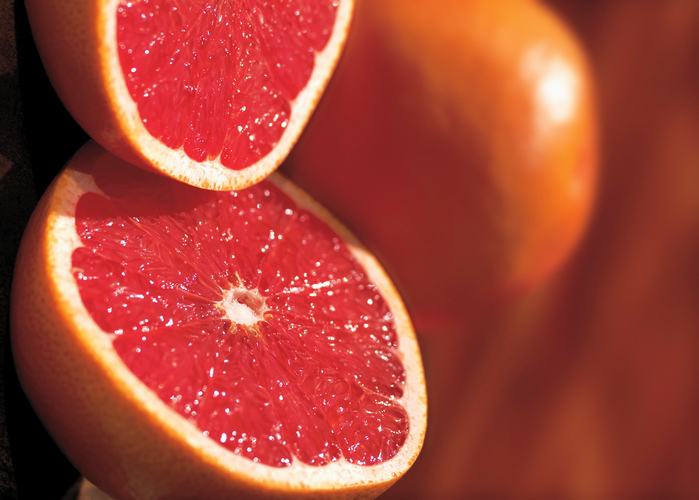
All grapefruit types are packed with nutrients, and nutrient level increases with depth of color. The best grapefruit develops in areas with hot days and warm to hot nights, resulting in lower acidity and higher sugar content.
RELATED: 7 Benefits Of Eating Grapefruit
But all grapefruit is not created equal. With grapefruit being low in fat and carbs, here are four types of grapefruit and what to use it for.
White
White grapefruit, also referred to as yellow, is the most traditional grapefruit type and is a favorite of commercial growers. It's widely used for juices and syrups. The meat is pale yellow and the juice is colorless. Juicy white grapefruits have a firm texture and tart flavor, but most white varieties have been increasingly engineered by growers to enhance their sweetness. Pink and ruby grapefruit were bred from the white grapefruit. Varieties include Duncan, Oroblanco, Golden, Wheeney, Sweetie, Melogold and the most popular, Marsh.
Benefits include: This fruit has a fat-burning enzyme and can help to absorb and reduce the starch and sugar in the body. It is widely consumed by people who are trying to lose weight.
RELATED: 10 Winter Foods That Fight Fat
Pummelo
The pummelo, also known as Chinese grapefruit, is considered the ancestor of the white, pink and ruby grapefruit. It's the largest of all citrus fruits, typically weighing 2 to 4 pounds. These ball-size fruits are used in rituals during Chinese New Year and are said to resemble a full moon. When ripe, the pummelo is pale green or yellow. Because of its sweet, mild taste and pleasant aroma, it's often used as a dessert, eaten raw, dipped in chocolate or sprinkled with salt.
Benefits include: This juice helps to promote digestion by increasing the flow of gastric juices. Eat the fruit together with its albedo and pith for their extra fiber that aids bowel movements.
Pink
Pink grapefruit is typically pale to light yellow with a pink blush. It gets its pinkish pigment from lycopene, a powerful cancer-fighting phytonutrient, and beta-carotene, which is converted to vitamin A in your body. This tasty citrus fruit is developed to have a balance of sweetness and tartness. The flesh of this exceptionally juicy fruit is pulpy and tender and it can range in color from chamois to variations of pink, although the juice is colorless. It's taste is sweeter than the white grapefruit. Many commercially propagated varieties are seedless. Varieties include Foster, Henderson, Marsh Pink, Ray Ruby, Redblush and Shambar.
Benefits include: The bioflavonoids found in grapefruit was discovered to even halt cancer cells from spreading in breast cancer patients, by ridding the body of excess estrogen.
Ruby
Ruby, or red grapefruit, has deep reddish flesh and juice. Like the pink grapefruit, its rich color is due to high levels of lycopene and beta-carotene. It's often smaller than the pink and white varieties. Like the pink grapefruit, ruby has a sweeter flavor than the white grapefruit due to greater balance between sugar level and acidity. Varieties include Rio Red, Flame and Star Ruby.
Benefits include: A diabetic can safely eat a grapefruit. In fact, more consumption of this fruit will help reduce the starches and sweets in the system. If you have a tendency towards diabetes, consume more grapefruit juice to prevent it.
RELATED: 10 Diabetes Superfoods
For more articles, Click here.








